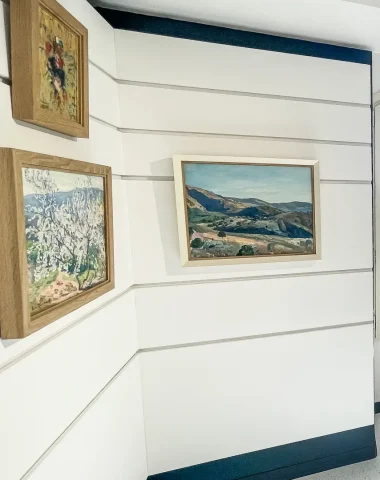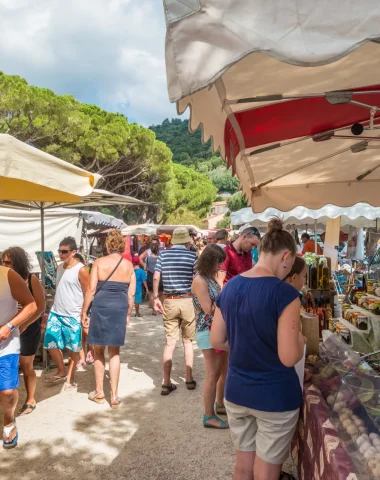Embark on a captivating journey along the Chemin des Sages, a project born from a visionary gathering of the Conseil des Sages, composed of wise individuals aged 60 and above, carefully chosen by local councilors for their wealth of experience. Inspired by the core principles of our Republican motto “Liberté, Égalité, Fraternité,” the council sought to breathe life into these ideals in the town of Bormes.
The Concept Takes Flight
A groundbreaking idea emerged during the council’s meeting—to adorn the town with phrases from renowned men and women, celebrated worldwide for their wisdom and humanism. The goal was to ignite the conscience of both passers-by and tourists, fostering a deeper connection with these universal values. To gain the support of the Mayor and the Council, the decision was made to integrate this pathway with the installation of historical plaques on the town’s iconic monuments. The members of the Conseil des Sages then meticulously designed the route through the medieval village and dedicated themselves to creating the perfect support, texts, images, and symbols for these plaques.

The butterfly, symbolizing joy, beauty, grace, and lightness of being, was chosen as the emblem of the project. Its transformative journey mirrors the essence of personal growth and rebirth. Just like the butterfly, we too experience different stages in life—a profound metamorphosis that allows us to release our past and embrace the beauty of who we’ve become. Symbolizing wisdom, the butterfly becomes a boundless source of inspiration. Beneath its delicate exterior lies an unwavering strength. Despite its ephemeral lifespan of a few days or weeks, the butterfly brings joy and exuberance through its graceful flight, fully savoring every moment that nature presents. Let us, like the butterfly, fearlessly embrace the experiences life offers us, both good and bad, knowing that they are fleeting. After all, our past experiences provide the best preparation for the future, allowing us to tread life’s paths with serenity.
The biography of Nelson Mandela
Lawyer and politician, symbol of the struggle against apartheid and Nobel Peace Prize winner.
This legendary figure, known by his tribal clan name “Madiba,” epitomizes the fight against apartheid, earning global recognition as a Nobel Peace Prize laureate. Born on July 18, 1918, in the Union of South Africa, Mandela’s extraordinary life is a testament to his indomitable spirit. Raised as the son of a tribal chief, he inherited a legacy of leadership and wisdom. Despite being orphaned at a young age, Mandela’s determination and unwavering resolve guided him towards a path of greatness. Venturing into the field of law, Mandela’s unwavering dedication propelled him towards academic excellence. In 1952, he established South Africa’s first black law firm, pioneering a movement that challenged the discriminatory practices of racial segregation. Joined by his compatriots in the African National Congress (ANC), Mandela waged a non-violent resistance, striving to secure equal rights for black South Africans.


As the struggle intensified, Mandela recognized the need for a stronger stance against the oppressive regime. In response to the brutal suppression of peaceful protests, he made the difficult decision to adopt a more confrontational approach. Taking charge of the ANC’s armed wing and orchestrating acts of sabotage, Mandela became a symbol of resistance, fearlessly standing against apartheid. In 1964, Mandela’s relentless pursuit of justice led to his unjust imprisonment, serving a life sentence for treason. Even behind bars, he refused to compromise his principles or abandon the struggle for freedom. Mandela’s indescribable fortitude captured the world’s attention, and he emerged as an iconic figure, inspiring countless individuals in the fight against apartheid. After 27 long years of confinement, Mandela’s release on February 11, 1990, symbolized a new era of hope and transformation. Afrikaner leaders, compelled by international pressure, acknowledged his significance and granted him freedom. With his unwavering resolve intact, Mandela embarked on a path of democratic transition, paving the way for a united and inclusive South Africa. In a historic moment, Nelson Mandela, the embodiment of the Black freedom struggle, was elected as South Africa’s president on April 27, 1994. His visionary leadership guided the nation towards reconciliation and dismantling the shackles of racial segregation. For his unwavering dedication to peace and equality, he was honored with the prestigious Nobel Peace Prize in 1993.
Following his presidential term, Mandela dedicated his life to philanthropy, channeling his energy into charitable endeavors. His tireless efforts continue to inspire individuals worldwide to embrace unity, compassion, and the pursuit of justice. On June 24, 1995, South Africa experienced a moment of immense pride as Mandela donned the jersey of the national rugby team. This symbolic act marked their return to the international stage after years of exclusion due to apartheid. In a stunning display of resilience, overcoming the phenomenal Lomu – the new All Black star, the team achieved victory in the World Cup, triumphing over formidable opponents and uniting a nation. On December 5, 2013, the world bid farewell to Nelson Mandela, a true visionary whose impact transcends borders and generations. His remarkable journey, spanning nearly a century, serves as an enduring testament to the power of hope, forgiveness, and the relentless pursuit of equality.
The Marin corkery
Discover the rich history and versatile applications of cork oak bark, a natural resource that has been utilized by humankind for centuries. Wherever cork oak thrives, its bark has served a multitude of practical purposes, showcasing its remarkable qualities. From providing reliable net floats for fishermen to crafting sturdy serving dishes for seafaring vessels, cork oak bark has proven to be rot-proof and highly functional. In earlier times, it even served as insulation and temporary shelter coverings for shepherds and charcoal burners.
The cork industry experienced a golden age, flourishing over the centuries and reaching its zenith in the mid-19th century. However, the process of harvesting cork requires patience and precision. It takes a minimum of ten years for the tree’s bark to develop the necessary thickness before a strip of cork can be skillfully removed using specialized tools. The extracted bark is then carefully dried for approximately six months and meticulously cleaned to ensure the removal of any impurities. Finally, the processed cork sheets are ready for delivery to factories, where they will be transformed into various products.

Initially, the production of corks relied on manual craftsmanship, using knives, which proved to be a time-consuming and inefficient method. However, with the advent of the industrial revolution, mechanization revolutionized productivity in the cork industry. Cutters were able to swiftly slice through the sheets, while semi-automated machines efficiently shaped the corks. The establishment of the Compagnie de Provence railroad further facilitated the export of local goods, including cork, enabling the industry to expand its reach. Nevertheless, as labor costs became a determining factor, other regions such as southwest France, Spain, North Africa, and Portugal emerged as competitors to the declining activity in the Maures mountains. By the turn of the 20th century, although a few butcher’s shops remained, their operations had significantly diminished compared to the previous century. The sale of the last machines in 1937 marked the end of an era, closing a chapter in the history of cork production.
Immerse yourself in the fascinating tale of cork oak bark, a natural marvel that has shaped industries and provided essential tools for generations. From its practical applications in fishing and seafaring to its significance in regional economies, cork oak bark has left an indelible mark on history. Experience the legacy of this remarkable material, one that continues to captivate and inspire even in the modern era.

To experience the full splendor of the Chemin des Sages and delve deeper into the fascinating stories that unfold along this path, we invite you to explore the Baludik app.
Scan the QR code and embark on an interactive journey filled with games, surprises, and a deeper connection to the rich heritage of Bormes.














